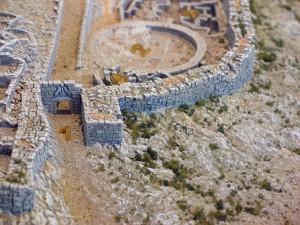|
Mycenae

The Mycenae Citadel Entrance: "The Gate Of The Lions" |
Welcome to Mycenae!
Mycenae is a pre-historic citadel built on a site that commanded the greater part of the plain, stretching southwards to the sea and the exit from the Pass of Dervenakia, fortified with Cyclopean walls with two gates (the Lion Gate and the North Gate) as well as two small auxiliary exits. The first walls were built around 1350 B.C. but the citadel itself assumed its presence form around the year 1200 B.C. A continuous supply of water was ensured by the Perseia Fountain close to the entrance of the acropolis, while the proximity of the fertile plain ensured food supplies.
The site's natural advantages thus enhanced its strategic position and it was inhabited very early in Neolithic times. The period of its greatest power, however, came at the close of the Late Helladic period (1600-1100 BC) which is also known as the Mycenaean period and with which many tales and legends are associated. In 1100 BC Mycenae was destroyed by fire.
Mycenae was founded by Perseus, son of Zeus and Danae, and the Perseid dynasty provided many of its rulers. After the last of them, Eurystheus (famous for the labors he imposed on Herakles), the Mycenaeans chose Atreus, son of Pelops and Hippodamia, as their ruler. But Atreus hated his brother, Thyestes, so much that he offered Thyestes his own children to eat, thereby incurring the wrath of the gods. Thyestes pronounced a fearful curse on Atreus and his progeny; Atreus's heir, the renowned and energetic Agamemnon, was murdered on his return from the Trojan War by his wife, Clytaemnestra, and her lover, Aegisthus (Thyestes's surviving son). Orestes and his sister Electra, the children of Agamemnon, took revenge for this murder, and Orestes became king of Mycenae. During the rule of his son, Tissamenus, the descendants of Herakles returned and claimed their birthright by force, thus satisfying the wrath of the gods and the curse of Atreus.

11670. The so-called Mycenaean Lady (Closer look) |
|

The Mycenae Citadel |
|

The Mycenae Citadel |
|

The Mycenae Citadel |
|
|
|
|
|



